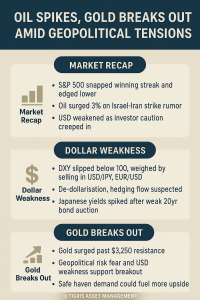
By Tigris Asset Management | May 2025
After a relentless rally, consolidation has finally returned. The S&P 500 snapped its winning streak, global equities pulled back modestly, and geopolitical tensions reemerged just as investor optimism started peaking.
The trigger? Reports of a potential Israeli strike on Iranian nuclear sites, rising bond yields in Japan, and renewed safe haven flows into gold. At the same time, the U.S. dollar broke below 100, suggesting something deeper: de-dollarisation and hedging flows may be quietly reshaping currency markets.
Ray Dalio, in a recent piece for Fortune, warned that the U.S. credit downgrade by Moody’s is not just symbolic — it marks an inflection point where “foreigners may no longer trust U.S. debt the way they used to.” Markets appear to be waking up to this.
Market Recap: Bulls Step Aside, Risk Reprices
- The S&P 500 edged lower, ending its streak amid rising geopolitical tensions and profit-taking.
- CNN reports, citing U.S. intelligence, suggested Israel may strike Iran’s nuclear facilities. This sent WTI crude oil up 3%, breaching $64 before cooling off slightly in Asia hours.
- Safe havens gold and JPY rallied, while risk assets paused.
USD Weakness and the Case for De-Dollarisation
- The Dollar Index (DXY) slipped below 100, driven by broad-based selling in USDJPY and EURUSD.
- A weak 20-year Japanese bond auction saw JGB yields spike, pushing 20y yields to 2.56% and 40y to 3.6%.
- This fuelled volatility in USDJPY, with 146.00 acting as resistance, while 140.00–142.00 forms key support.
- EURUSD continues to perform, with buying seen during Asian and European sessions, while NY opens with selling pressure. This flow may reflect global hedging and reserve diversification — a theme consistent with Dalio’s warning that the global trust in U.S. fiscal stability is deteriorating.
“History shows that great empires decline when their debt becomes unsustainable and trust in their institutions erodes,” writes Dalio.
Gold Breaks Out — Again
- Gold surged past $3,250–3,260, breaking through last week’s resistance after Israeli-Iranian strike rumors resurfaced.
- Renewed buying in New York hours and into early Asia trading further supported prices.
- Ongoing USD weakness strengthened the safe-haven bid.
What Should Investors Watch?
In the Short Term:
- Watch oil closely: If Israeli threats materialize, expect a new wave of inflation volatility and energy-led risk aversion.
- Gold could accelerate: If geopolitical tension escalates or USD weakness deepens, gold may extend toward new all-time highs.
- Bond yields & FX volatility: Japanese yields are quietly reshaping carry trades. USDJPY and EURUSD are no longer range-bound — they’re data- and headline-sensitive again.
In the Mid Term:
- Dalio’s warning on U.S. debt credibility should be taken seriously. A weaker dollar, rising Treasury yields, and declining global demand for U.S. debt could lead to:
- Tighter financial conditions
- Repricing of U.S. risk assets
- Greater capital flow dispersion across EMs and hard assets
- De-dollarisation is not theoretical anymore. It’s happening in slow, structural ways: through bilateral trade deals, FX reserve diversification, and sovereign hedging.
Key Data Ahead
- Today’s focal point: UK CPI. A hotter print could reshape Bank of England expectations and drive further FX volatility.
Conclusion: A Delicate Crossroad
Markets are not panicking. But they are blinking. The combination of rising geopolitical risk, structural cracks in U.S. fiscal credibility, and real-time currency adjustments is pushing global investors into a new phase: one that prioritizes resilience over growth, hedges over momentum, and real assets over leverage.
The past week may not mark a collapse — but it very well may mark a turning point.
For more insights, visit the Tigris Asset Management blog.
Why Markets Are Entering a New Phase of Fragility


No Comments